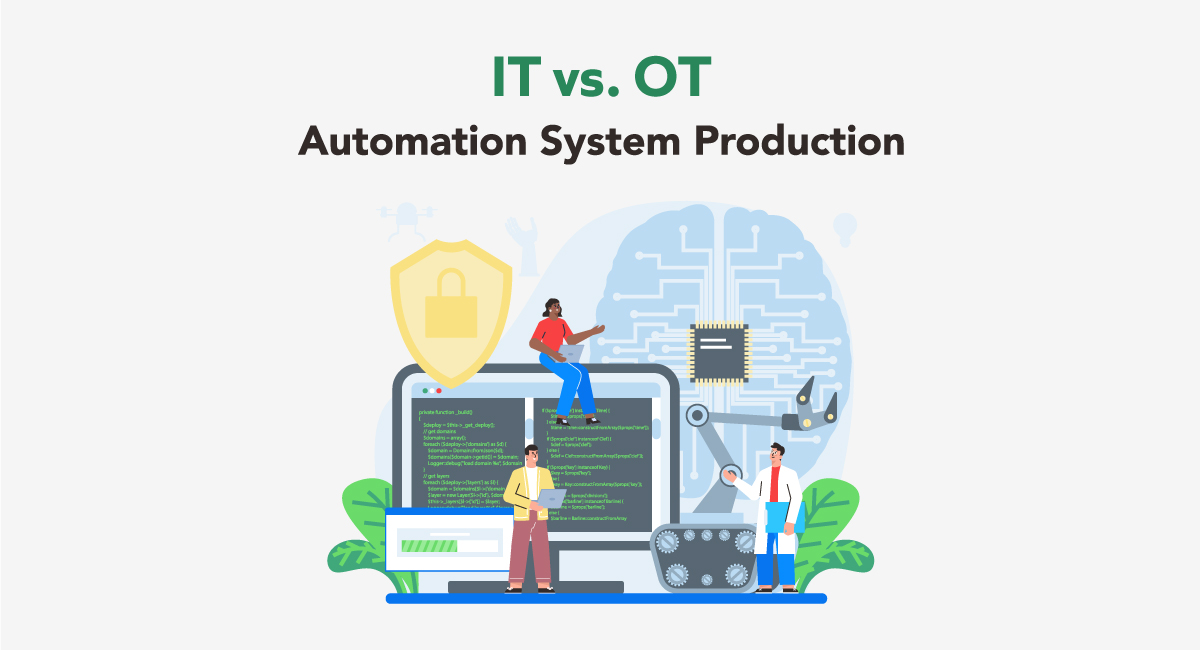- IT vs. OT: What’s the Difference and Why Does It Matter for Industrial Automation
- What is IT?
- What is OT?
- What distinguishes OT from IT most significantly?
- Difference between OT and IT
- Difference between IT Network and OT Network:
- What do IT and OT teams focus on?
- What distinguishes IT and OT devices from one another?
- How do OT and IT networks differ?
- What Separates IT from OT, Specifically?
- IT vs. OT Security Threats
- Conclusion
IT vs. OT: What’s the Difference and Why Does It Matter for Industrial Automation
Information Technology (IT) and Operational Technology (OT) are two essential ideas that are at the forefront of the dynamic world of industrial automation. Modern industrial processes’ efficiency, productivity, and innovation are significantly influenced by these two domains. The synergy between IT and OT can either pave the way for unprecedented advancements or lead to complex challenges.
What is IT?
When creating, processing, storing, safeguarding, and exchanging any kind of electronic data, computers, data storage, and networking are employed as part of the IT (Information Technology) infrastructure and processes. Data processing systems hold an organization’s information, making it available to business applications and the users of those applications. While IT systems act as data repositories and processors, their OT equivalents are in charge of producing the data that IT systems process.
What is OT?
OT (Operational Technology) systems perform modifications in business and industrial operations by monitoring events, processes, and physical equipment. Industrial control systems, including supervisory control and data acquisition, as well as computerized numerical control (CNC) machining systems, are common examples of OT systems used in manufacturing contexts.

What distinguishes OT from IT most significantly?
Any organization’s technology foundation is its IT department. Core operations, including email, finance, human resources (HR), and other applications in the data center and cloud, need to be monitored, managed, and secured. Industrial operations within a company are connected, managed, and secured using OT. OT is laboriously operated by businesses in a broad range of initiatives, including manufacturing, mining, oil & gas, utilities, and transport. Robots, CNC methods, PLCs, SCADA methods, industrial control systems (ICS), and supervisory control and data acquisition (SCADA) techniques are rare instances of OT.
Operational Technology is present in outdoor spaces like parking lots and highways as well as in warehouses. Examples of OT include weather stations, service fleets, connected buses and trains, ATMs and kiosks, and a system that enables a city to manage electric vehicle charging stations. The primary distinction between IT and OT is that the former focuses on an organization’s front-end informational activities, while the latter focuses on its back-end production (machines).
Difference between OT and IT
Since we are directly aware of the phrases, let’s examine how they conflict:
In difference to IT, which is concentrated on data managing, flow, network management, and authentication, OT is involved with handling and managing physical credentials to the system. This indicates that OT is focused on industry, whereas IT is focused on business.
If OT is unsuccessful, life may also be harmed. Any unsafe operation or control of equipment poses a risk to the immediate environment as well as to humans because it involves machines. Data loss may result from an IT malfunction.
Standard operating systems (OS) like Windows or Linux are used to run IT. However, OT utilizes specialized systems and software. According to the manufacturer.
While OT uses a variety of protocols, IT typically runs everywhere on the Ethernet standard. It varies from manufacturer to manufacturer once again.
Device performance is key to OT, which is device-centric. IT is network- and data-centric and is reliant on the management, transmission, and control of data.
Difference between IT Network and OT Network:
| IT Network | OT Network |
|---|---|
Business-focused and primarily concerned with information rather than devices or IT networks. | The OT network mostly communicates with machines and has an industrial focus. |
IT networks use a variety of data types, including transactional, phone, video, and big data. | In OT networks, several forms of data include monitoring, control, and supervisory data. |
Access to the IT network is restricted to those with specific privileges. | The OT network is linked to the outside world, to which anyone can have access. |
Data is processed transactionally by the IT network. | The OT network operates by processing data in real time. |
There may be automated risks with the IT network. | Information threats may exist in the OT networks. |
Data loss may occur as a result of IT network failures. | End-of-life may occur as a result of an OT network failure. |
The environment for IT changes regularly. | Due to the few changes in needs, the OT environment is less dynamic. |
Network upgrades for IT networks are frequent. | Network improvements are only necessary for the OT network during operational maintenance windows. |
Depending on the industry, an IT network failure may affect the firm. | Any disruption to the OT network will have an immediate effect on the entire company. |
By logging in to people and devices, the IT network maintains security. | Any device’s physical access is controlled by the OT network. |
What do IT and OT teams focus on?
An organization’s informational infrastructure is the responsibility of the IT department. IT teams concentrate on upholding uniform policies and control throughout the organization. IT is in charge of preventing unauthorized access to sensitive applications and private data. The machinery on industrial sites is under the control of the OT department. It is concentrated on both worker safety and production output. The team pays special attention to the uptime and maintenance of machines because OT performance is essential to the company’s earnings.
OT is focused on having machines have an impact on the actual environment, in contrast to IT, which is primarily concerned with making data accessible. Additionally, machines might produce data that must be processed and saved to monitor industrial operations and assist operators in making decisions such as predictive maintenance.
What distinguishes IT and OT devices from one another?
IT equipment typically has a lifespan of three to five years, is replaceable, and requires little upkeep. They frequently use mainstream operating systems like Windows, iOS, and Linux. Since OT devices are frequently custom-made, they frequently contain specialized software and may employ proprietary protocols. Because industrial sites are intended to last for many years or even decades, they have a much longer lifespan. As they manage crucial infrastructure, OT devices may need to run continuously and without interruption.
Additionally, OT systems and devices may have multiple software vulnerabilities because they aren’t updated as frequently as IT systems and devices. Because they might be located in inhospitable places or severe settings, accessing them might be challenging. They might even be under the control of suppliers or partners. Since each change—even a straightforward software update—can have several cascading impacts on the industrial process, adjustments to OT devices may, in all situations, be the subject of a complicated approval process.
How do OT and IT networks differ?
Network infrastructures for OT and IT share components such as wireless technologies, switches, and routers. To establish a strong network foundation, OT networks can profit from the rigor and knowledge that IT has amassed over the years with common network administration and security rules.
But there are some significant variations:
- Form factor:
Smaller and more modularly designed OT network devices can be put in a variety of places, including cars, light poles, railings, walls, and even integrated within other pieces of machinery.
- Hardening:
When used in harsh industrial environments, OT network infrastructure may need to be ruggedized. The infrastructure needs to be resilient to water, water pressure, high and low temperatures, as well as corrosive air and chemicals.
- Network Interfaces:
OT devices may enable networks like LoraWAN or WiSun to connect industrial IoT (IIoT) devices, depending on their intended use.
- Protocols:
IoT sensors and machines are connected by OT network devices, which utilize communications protocols uncommon in typical IT networks. Consequently, a wide range of protocols, including Modbus, Profinet, and the Common Industrial Protocol (CIP), must be supported by industrial networking equipment.
What Separates IT from OT, Specifically?
While OT focuses on what the data means and how it may best drive linked assets, IT concentrates on the data’s existence. Additional significant differences between IT and OT include:
Device Maturity
IT gadget technology has been around for a while. It is simpler and less difficult to produce. OT equipment is an evolving collection that tries to keep up with new developments in digital technologies. To program a converged system for optimization, IT teams and OT departments must collaborate as the need for cross-field communication between the two grows.
Cost
Many businesses with outdated IT infrastructure are reluctant to invest in new CAPEX projects since they come with a steep learning curve for the new technology. Some people are hesitant to go to the cloud, much less OT and industrial IoT, because they have invested in cables, service providers, fiber, and skill sets. However, entry costs have drastically decreased for both OT devices and industrial IoT systems. The ROI for cloud-based machine monitoring platforms and devices is far cheaper than the long-term upkeep of conventional IT when combined with productivity increases and a lower total cost of ownership over time.
Data Management
Real-time data processing is the main focus of OT. It includes several sorts of data, such as monitoring data, control and data collection data, and supervisory data since it is focused on machine status and condition. IT focuses on transactional data, which can include video processing, office communications, and substantial amounts of unstructured data.
Safety
Data loss, which could have an impact on the business, is the most serious consequence of an IT equipment failure. However, since OT keeps an eye on physical assets, it can aid in averting expensive catastrophic equipment breakdowns.
IT vs. OT Security Threats
Companies have made significant investments in safeguarding their networks because IT has always been security-conscious. When companies started shifting IT functionality to the cloud, these worries grew. But cloud-based security has substantially improved. Passwords, access, and authorization methods pose a greater threat to cloud-based data than assaults do today, which is the same as it was when networks were internal.
OT was initially cut off from the outer world. However, as the Internet of Things expanded throughout the Fourth Industrial Revolution, OT devices were more open to outside attacks. To manage access, many OT security initiatives concentrate on the application layer. On the other hand, IT aims to protect employee safety and guarantee the uninterrupted operation of connected assets by securing company data. Security risks will persist, posing a challenge to OT teams with more sophisticated attacks. However, as the divisions between IT and OT become less distinct, many security changes will be created in layers with various procedures to safeguard various system levels.
Conclusion
In the intricate tapestry of industrial automation, the juxtaposition of Information Technology (IT) and Operational Technology (OT) weaves a narrative of synergy and transformation. The dance between digital insights and physical orchestration orchestrates a symphony of efficiency, productivity, and innovation. The convergence of IT and OT, with its promise of informed decision-making, predictive power, and safeguarded operations, paints a vibrant portrait of the future of industrial automation. As industries embrace this convergence, they embark on a journey towards Industry 4.0, where possibilities are boundless and uncharted terrain beckons with untold potential. In this realm, the distinction between IT and OT blurs, giving rise to a harmonious union that propels industrial automation into a new era of excellence.







